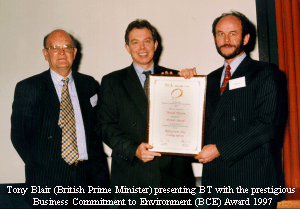降低有害气体的排放
日期:2012-06-27
Flovent Contributes to a Cleaner Environment

In June this year, at the second Earth Summit held in New York, the British Prime Minister, Tony Blair, announced that Britain was the only industrialised country to meet the targets for the reduction of harmful gas emissions set at the first Earth Summit, held in Rio de Janeiro five years ago.
Flomerics feels proud to have played a part in helping Britain achieve this goal. By working with the FLOVENT software, British Telecom (BT), the major British telecommunications operator, has managed to reduce its energy consumption by an amount equivalent to more than 22 tons of fossil fuel per exchange per annum as well as total elimination of CFC and HCFC emitting refrigeration units in their new exchange housings.
Flovent Helps BT Win Environmental Award
In February 1997, BT won the prestigious Business Commitment to the Environment award (BCE) for their contribution in reducing harmful gas emissions. The reduction in energy consumption was achieved by using the FLOVENT software and Flomerics' consulatancy, Flovent Modelling Services (FVMS), to accurately predict the airflow and temperature distribution in individual exchanges.
Traditionally, the main priority for all telecommunication operators - including BT - has been to keep their lines open even under extreme conditions. Overheating in the exchanges is often a problem, and as reliability is paramount and therefore, the exchange equipment and facilities are kept within a certain temperature range. To achieve this, BT used refrigeration units to introduce cool air down the gangways housing the exchange equipment. Both the level of refrigeration and the method of distributing the cold air were based on rules of thumb - which at best resulted in over-engineering, and at worst did not satisfactorily cool the environment within the exchanges.
When looking for possible ways to improve this situation, BT were aware that the high latitude of the UK could allow a far more effective use of outside air in keeping the exchange housings at an acceptable temperature throughout the year.
However, the different layouts of the exchanges and the non-uniform heat dissipation, coupled with the problem of how to introduce outside air into the buildings, raised issues that could not readily be resolved with confidence.
The discovery of FLOVENT's airflow modelling software allowed BT to experiment with new cooling designs using fresh air. By creating a three-dimensional computer model of each exchange, FLOVENT software could provide an accurate picture of the airflow and temperature distribution, as well as demonstrating exactly how changes to the cooling and ventilation systems would influence both the temperature range and airflow.
The results of using FLOVENT software have been spectacular.
Since August 1995, BT has been using fresh air cooling systems in more than 90% of new buildings that house their latest telecommunications systems. This has led to the near total elimination of the CFC and HCFC emitting refrigeration units required by traditional ventilation systems.
Furthermore, BT estimates that the introduction of simple fan assisted air handling units has reduced energy consumption by an amount equivalent to more than 22 tons of fossil fuel per exchange per annum.
And there has been the additional advantage of reducing the total life cycle cost of BT's exchanges by over 50%.









 沪公网安备 31010602003953号
沪公网安备 31010602003953号